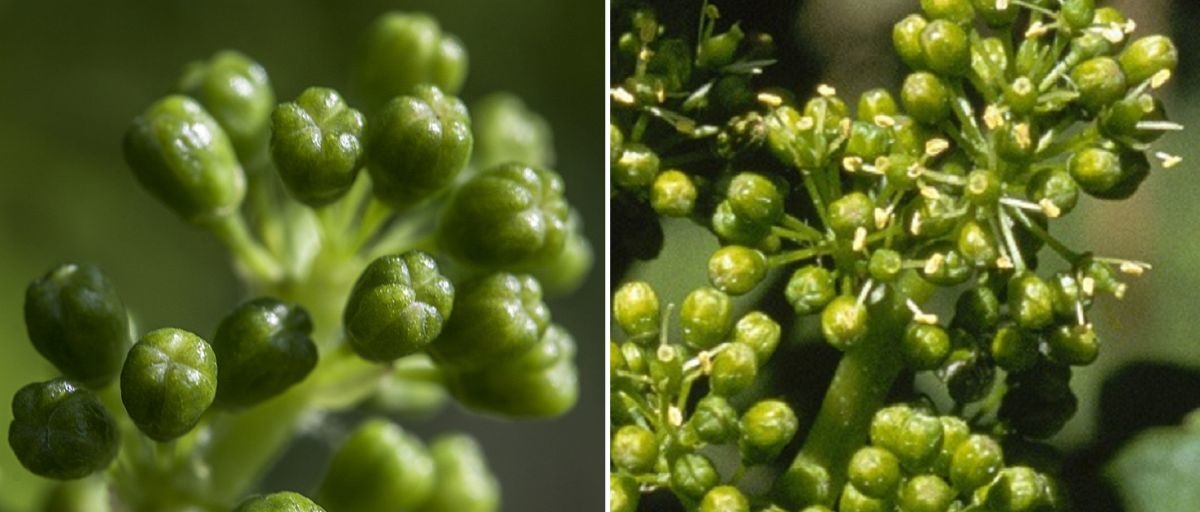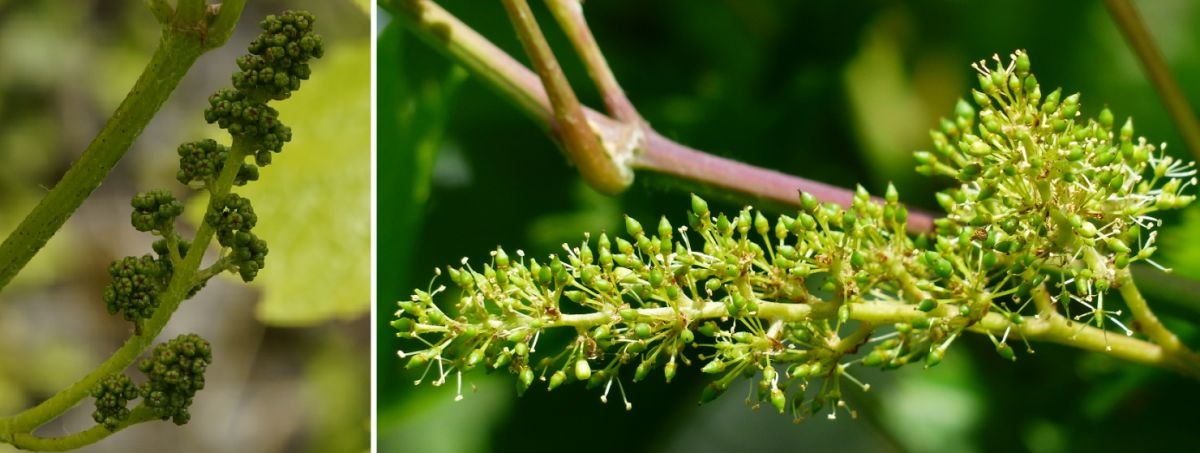Name for the inflorescence (glow) of the vine; see under flower.
Blossom
This stage of the grapevine 's annual vegetation cycle begins six to eight weeks after budding. The timing depends on the year-specific temperature development, the temperatures reached at the respective location and the typical growth of the variety under changing weather conditions. Constantly warm temperatures with a good water supply accelerate shoot growth and thus the formation of the inflorescence (Latin: inflorescence, also known as the flower, umbel, dome or spike) on the third to seventh shoot node.
Hermaphrodite flower
The flower bud of the cultivated grapevine is bisexual. Around 99% of all grapevines are hermaphrodite flowers, whose two sexes are united in one organ. The male sexual organs are the stamens or stamina, which consist of the stalk-shaped filament and the yellowish anthers at the tip. The entirety of the stamens of a flower is called the androecium. An anther contains four pollen sacs, where the pollen grains with the male gametes (pollen, pollen) are formed. In the flower, five of these free-standing stamens surround the female reproductive organ in a circle.
The female reproductive organ consists of two fused carpels, which contain two compartments with ovules inside. This is why the grapevine is an angiospermous flowering plant. The organ consists of the ovary with the female ovules and the stigma to be pollinated. This makes fertilisation much easier than with unisexual plants. In more than 98% of cases, self-pollination (self-fertilisation) occurs, so that no external help or influence (such as wind or bees) is necessary.

The picture on the left shows a closed vine flower, the picture in the middle shows the shedding of the cap before pollination and the picture on the right shows the flower bud in full bloom shortly before pollination or fertilisation. 1 = five-lobed corolla (cap), 2 = stigma, 3 = anther, 4 = filament, 5 = pistil, 6 = ovary, 7 = nectaries (honey glands), 8 = calyx.
Ovary, pistil and stigma
The ovary merges at its tip into the pistil, which ends in the stigma. The disc-shaped stigma is a spongy tissue that secretes sticky secretions which cause the pollen to stick during the fertilisation process. The pollen can come from its own flower, a flower on the same vine, a flower on a different vine or a flower on a different vine. There are five nectar glands (honey glands) at the base of the stamens and the ovary, which are fused together to form a ring (discus or calyx).
Five weakly developed sepals and five green petals that have grown together to form a cap cover the stamens and the ovary in the form of an inverted calyx. This yellow-green perianth (cap, caplet, perianthium) is shed at the beginning of flowering, after which pollination by pollen and subsequent fertilisation can take place.

The top left picture shows the closed flower buds with the caps before and the right picture after shedding. The picture on the bottom left shows the flower before shedding and the picture on the right shows a full flower with 50% fertilised buds.

Beginning of flowering
Depending on the zonal climate, microclimate and solar radiation, flowering in the northern hemisphere takes place from mid-May to July (in Central Europe, according to the old winemaker's rule, it begins on 24 June = St. John's Day, plus or minus eight days), in the southern hemisphere from November to mid-December. In contrast to many other flowering plants, the flowers of the vine are small, greenish-yellow in colour and rather inconspicuous due to the lack of petals and showy flowers. The individual grape berries form from the individual flowers as the fruit ripens.
Pre-flowering
In the pre-flowering stage, the long axis of the inflorescence stretches, then the lateral branches with the still closely packed, closed individual flowers spread out. With increasing development, the individual flowers detach from the flower cluster, swell and change colour to greenish-yellow shortly before the actual start of flowering. Flowering begins when the first petals (perianthium), which have grown together to form a flower cap, detach from the base of the flower in dry, warm weather. When the humidity is low, the caps are shed by means of a cleverly devised spring mechanism so that the honey-scented stigmas are exposed and the stamens can spread. At this point,...
Voices of our members

wein.plus is a handy, efficient guide to a quick overview of the colourful world of wines, winegrowers and grape varieties. In Wine lexicon, the most comprehensive of its kind in the world, you will find around 26,000 keywords on the subject of grape varieties, wineries, wine-growing regions and much more.
Roman Horvath MW
Domäne Wachau (Wachau)